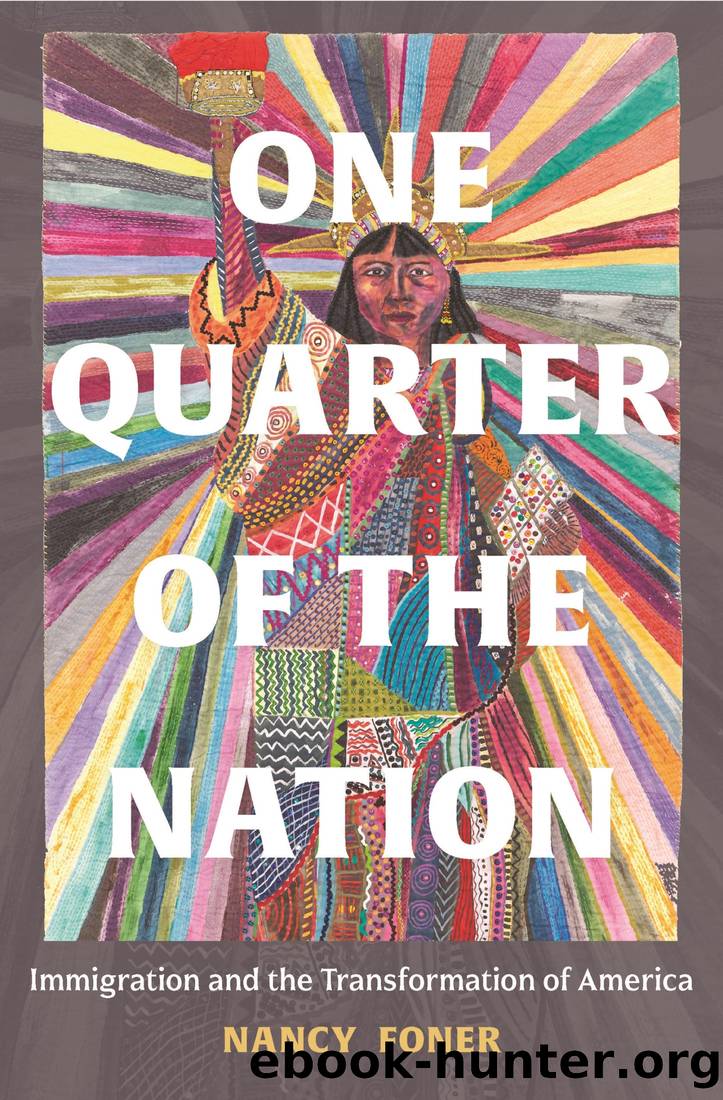One Quarter of the Nation by Nancy Foner

Author:Nancy Foner [Foner, Nancy]
Language: eng
Format: epub
ISBN: 9780691206394
Publisher: Princeton UP
Published: 2021-10-25T00:00:00+00:00
* * *
The innovations in Hamilton are unlikely to raise the hackles of most Americansâthough to be sure, the showâs stress on ethnic and racial diversity might concern some. To the extent that popular culture champions ethnic and racial diversityâand Asian Americans, Latinos, and Blacks are seen as making significant headway in various popular culture arenasâthis may add to resentments among those, particularly less well-off Whites, who believe that people of color are gaining advantages at the expense of Whites and that the America they remember, of taken-for-granted White hegemony, is no more (see chapter 6).
And yet these same people generally are happy to eat Chinese or Mexican food; may eagerly watch movies or television programs that star Latinos or Asian Americans; and often delight in listening and dancing to melodies of Afro-Caribbean and Latin singers. Their college-educated children may enjoy novels by immigrant-origin authors. Few, I imagine, would have turned down a ticket to Hamilton.
By and large, the changes in popular culture and the arts I have discussed have not upset most Americans, or been points of bitter contention or conflict. In her analysis of food, Gabaccia puts forward one reason: the pursuit of pleasure with minimal obligation encourages Americans to cross cultural boundaries and incorporate parts of other cultures into their intimate lives. Americans, she observes, have not been as tolerant of and curious about their neighbors as they have about their neighborsâ foods: âConsumers need not convert to Judaism or have Jewish friends to relish lox and bagels; they donât need to understand Islam or its faithful to enjoy babaganoush.â66 Beyond food, long-established Americans donât need to have Cuban American friends to enjoy the music of Estefan, African friends to be drawn to Adichieâs novel Americanah, or Pakistani friends to appreciate movies with a South Asian lead like The Big Sick. The same goes for attending a host of immigrant celebrations in cities all over the country, from Caribbean carnivals to Cinco de Mayo festivals.
The Cinco de Mayo festivals are a good example of an aspect of cultural change that has come up throughout this account: how customs from immigrantsâ home countries become the basis for new mixtures in the American context. What was a relatively minor holiday in most of Mexico commemorating a military victory has become more important in this country among Mexican Americans as a celebration of their Mexican heritageânot only involving Mexican food and music, but in the American way of many public festivals, frequently carnival rides as well. In at least one city, Portland, Oregon, the celebration has included a naturalization ceremony for new citizens.67
Popular music is full of new cultural combinations pioneered by immigrants and their offspring, from rap to Latin sounds and genres. Foods with origins in homeland cuisines, as they have developed in the United States, have often Americanized to some degree, in the case of General Tsoâs chicken, sweetened and with added broccoli to appeal to American tastes, or to mention salsa, the addition of new types with different degrees of spiciness (or mildness) and sweet versions to serve with dessert.
Download
This site does not store any files on its server. We only index and link to content provided by other sites. Please contact the content providers to delete copyright contents if any and email us, we'll remove relevant links or contents immediately.
Cecilia; Or, Memoirs of an Heiress — Volume 1 by Fanny Burney(32023)
Cecilia; Or, Memoirs of an Heiress — Volume 3 by Fanny Burney(31438)
Cecilia; Or, Memoirs of an Heiress — Volume 2 by Fanny Burney(31386)
The Great Music City by Andrea Baker(30759)
We're Going to Need More Wine by Gabrielle Union(18608)
All the Missing Girls by Megan Miranda(14621)
Pimp by Iceberg Slim(13750)
Bombshells: Glamour Girls of a Lifetime by Sullivan Steve(13667)
Fifty Shades Freed by E L James(12888)
Talking to Strangers by Malcolm Gladwell(12826)
Norse Mythology by Gaiman Neil(12791)
For the Love of Europe by Rick Steves(11339)
Crazy Rich Asians by Kevin Kwan(8864)
Mindhunter: Inside the FBI's Elite Serial Crime Unit by John E. Douglas & Mark Olshaker(8667)
The Lost Art of Listening by Michael P. Nichols(7138)
Enlightenment Now: The Case for Reason, Science, Humanism, and Progress by Steven Pinker(6855)
The Four Agreements by Don Miguel Ruiz(6289)
Bad Blood by John Carreyrou(6258)
Weapons of Math Destruction by Cathy O'Neil(5803)
